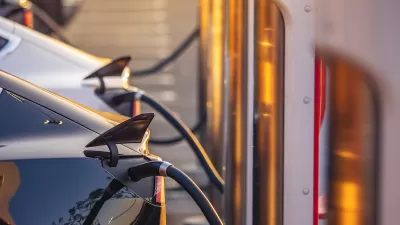Environmental sustainability on a national level is proving to be financially unsustainable on a local level for an island community in Norway that is counting on $20 tolls, with an electrical vehicle exemption, to pay off a $70 million tunnel.

Remember those warnings from transportation analysts that electric vehicles (EVs), which don't pay any gas taxes, would exacerbate the transportation funding crisis? Well, with less than 1 percent market share, EVs can't be blamed for the current Highway Trust Fund shortfall in the United States, but they can be blamed for a financial drain on a toll-financed, 3.5 mile undersea road tunnel that opened in 2009 for the 3,000 residents of the Norwegian island community of Finnøy.
Thanks to Norway's climate policies that exempt electric vehicles from paying tolls, the emission-free vehicles "now account for about a quarter of tunnel traffic, and allow owners to dodge one of the heaviest toll burdens in the country," writes Kjetil Malkenes Hovland for The Wall Street Journal.
“That doesn’t work in the long term,” says [Mayor] Gro Skartveit, who doubles as chairwoman of the company operating the tunnel. “We won’t be able to pay down the tunnel.”
Finnøy is not alone. There are 33 locally financed undersea road tunnels. The central government is aware of the problem. It "said in May it would gradually reduce incentives from 2018," writes Hovland.
Largely as a result of those perks, "one in five new cars sold in [June in] Norway was electric, up from one in eight a year earlier," writes Hovland. According to our January 2014 post, at the end of 2013, Tesla was the best-selling car, and the Nissan Leaf number three.
The government estimates it will lose over half a billion dollars in tax revenue on electric cars this year, while free parking and toll exemptions will cost tunnel, ferry and road operators another $40 million.
Tesla believes they can by bringing down the cost of EVs.
“If we didn’t have cheaper cars on the market by the time [Norwegian] incentives are reduced, we would be hit,” said Tesla’s Scandinavia spokesman Esben Pedersen. “But prices of electric vehicles are only going down, and Tesla will have a cheaper car on the market by 2017.”
What about the United States?
"Weaning buyers from such purchase incentives could add new headwinds to sales of vehicles already undercut by cheap fuel prices in some markets," writes Hovland. "In the U.S., the state of Georgia halted its $5,000 tax credit on July 1."
Electric cars were about 2% of purchases in the state in 2014, estimates Washington-based think tank Keybridge Research LLC. It forecasts a 90% decline, or 8,700 fewer sales annually, as a result of the loss.
Asked to comment on the anticipated hit to the EV industry in the Peach State, a Union of Concerned Scientists spokesman pointed to the remaining perks the EVs will enjoy: "Workplace charging stations, access to high-speed highway lanes and price breaks offered by utilities, could help mitigate the loss of tax incentives in the state, he said."
All of which begs the question: How essential are perks to the EV industry, and what happens if they are removed?
FULL STORY: Electric-Car Perks Put Norway in a Pinch

Alabama: Trump Terminates Settlements for Black Communities Harmed By Raw Sewage
Trump deemed the landmark civil rights agreement “illegal DEI and environmental justice policy.”

Study: Maui’s Plan to Convert Vacation Rentals to Long-Term Housing Could Cause Nearly $1 Billion Economic Loss
The plan would reduce visitor accommodation by 25% resulting in 1,900 jobs lost.

Planetizen Federal Action Tracker
A weekly monitor of how Trump’s orders and actions are impacting planners and planning in America.

Waymo Gets Permission to Map SF’s Market Street
If allowed to operate on the traffic-restricted street, Waymo’s autonomous taxis would have a leg up over ride-hailing competitors — and counter the city’s efforts to grow bike and pedestrian on the thoroughfare.

Parklet Symposium Highlights the Success of Shared Spaces
Parklets got a boost during the Covid-19 pandemic, when the concept was translated to outdoor dining programs that offered restaurants a lifeline during the shutdown.

Federal Homelessness Agency Places Entire Staff on Leave
The U.S. Interagency Council on Homelessness is the only federal agency dedicated to preventing and ending homelessness.
Urban Design for Planners 1: Software Tools
This six-course series explores essential urban design concepts using open source software and equips planners with the tools they need to participate fully in the urban design process.
Planning for Universal Design
Learn the tools for implementing Universal Design in planning regulations.
Caltrans
Smith Gee Studio
Institute for Housing and Urban Development Studies (IHS)
City of Grandview
Harvard GSD Executive Education
Toledo-Lucas County Plan Commissions
Salt Lake City
NYU Wagner Graduate School of Public Service





























